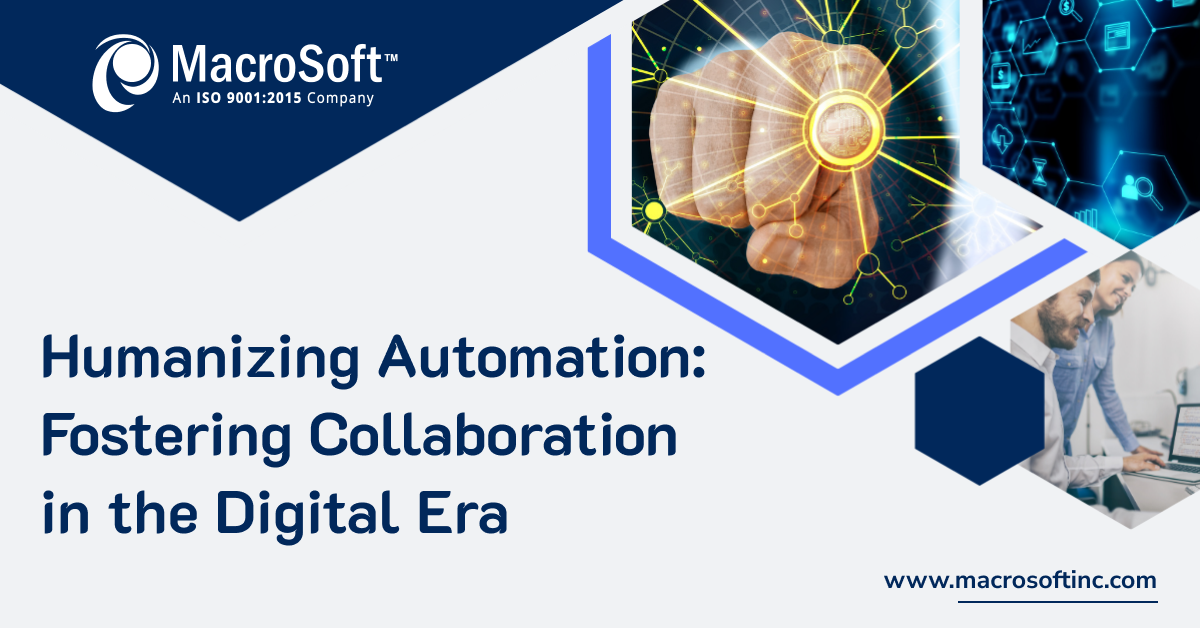

The digital era is characterized by rapid technological advancements, with automation playing an increasingly central role in businesses across all industries. While automation offers undeniable benefits in terms of efficiency, accuracy, and cost reduction, concerns exist about its impact on the human workforce. However, the future of work isn’t a battle between humans and machines; it’s about fostering collaboration and synergy between the two. Here’s why humanizing automation is crucial and how you can achieve it:
The Rise of Automation and its Benefits:
A McKinsey Global Institute report estimates that up to 800 million jobs globally could be automated by 2030. However, the report also highlights that automation will create new jobs, requiring a shift in skillsets. Companies that embrace human-machine collaboration will be best positioned to thrive in this evolving landscape.
Automation offers several key benefits:
- Increased Efficiency: Repetitive tasks are automated, freeing up human employees to focus on higher-value activities that require creativity, critical thinking, and problem-solving skills.
- Improved Accuracy: Machines excel at completing tasks with consistent precision, minimizing errors and ensuring quality control.
- Reduced Costs: Automation can significantly reduce labor costs associated with repetitive tasks.
- Enhanced Data-Driven Decision Making: Automated processes generate valuable data that can be used to gain insights, optimize workflows, and make informed business decisions.
Why Humanizing Automation Matters
While automation offers numerous advantages, neglecting the human element can have detrimental consequences:
- Job Displacement: Automation can lead to job losses, particularly in sectors with a high concentration of routine tasks.
- Skill Gaps: The emergence of new technologies requires a continuous upskilling and reskilling of the workforce.
- Decreased Employee Morale: Feeling replaced by machines can lead to employee disengagement and a decline in morale.
- Ethical Considerations: Automation raises ethical questions concerning bias in algorithms and the potential for job displacement.
The Power of Human-Machine Collaboration
Humanizing automation means creating a work environment where automation complements and amplifies human capabilities. Here are some strategies to achieve this:
- Focus on High-Value Tasks: Leverage automation for repetitive, data-driven tasks, freeing up human employees to focus on tasks that require critical thinking, creativity, and emotional intelligence.
- Invest in Upskilling and Reskilling: Equip your workforce with the skills needed to thrive in the digital age. This may involve training in areas like data analytics, digital marketing, and human-centered design.
- Foster a Culture of Continuous Learning: Cultivate a learning environment where employees are encouraged to embrace new skills and technologies. Explore resources like Coursera or Udemy to find online learning opportunities for your employees.
- Maintain Human Oversight: Human oversight is crucial for ensuring ethical decision-making and preventing bias in automated systems.
- Embrace Human-centered Design: Design automation solutions with human needs and capabilities in mind. Automation should complement human work, not replace it.
Macrosoft: Your Partner in Humanizing Automation
Macrosoft offers a comprehensive suite of process automation solutions designed to streamline workflows and improve efficiency while keeping the human element at the forefront. Our solutions enable businesses to:
- Automate Repetitive Tasks: Free up your employees to focus on more strategic initiatives.
- Improve Data Visibility: Gain real-time insights into your processes for better decision-making.
- Enhance Collaboration: Foster seamless collaboration between humans and machines.
- Empower your Workforce: Equip your employees with the tools and skills they need to succeed in the digital age.
Conclusion
Automation is here to stay, but it doesn’t have to come at the expense of human jobs or well-being. By humanizing automation and fostering collaboration, businesses can unlock the full potential of both humans and machines, creating a future of work that is efficient, productive, and human-centered.
Ready to Get Started?
Contact Macrosoft today to discuss how our process automation solutions can help you humanize automation in your organization and empower your workforce for the future.
By Allen Shapiro, Suryagayathri C K | April 24th, 2024 | Process Automation
Recent Blogs


Generative AI in 2024: A Year of Evolution and Enterprise Adoption
Read Blog

Beyond the Resume: Showcasing Your Soft Skills for Lasting Job Success
Read Blog

Future-proofing Customer Communications: Key Features to Look for in CCM Solutions
Read Blog


 Home
Home Services
Services






































